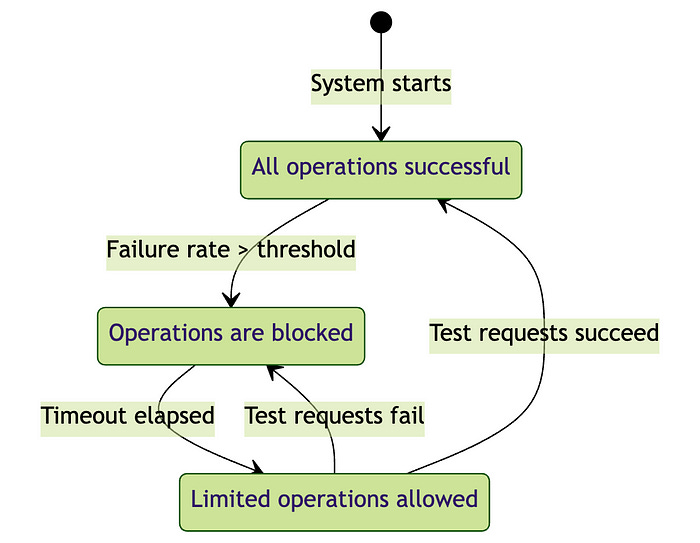The Circuit Breaker Pattern in Microservices: An In-Depth Look
Explore the Circuit Breaker pattern in microservices. Boost system reliability, prevent cascading failures, and ensure graceful degradation during outages.
In our daily life, we’ve come across circuit breakers — the electrical ones, not the design pattern. Yet! The principle behind the electrical circuit breaker and the design pattern we’re going to discuss is quite similar. When a problem arises, it “trips” to prevent further damage, and once the problem is fixed, it “resets” to normal operation.
Today, let’s get up-close and personal with the Circuit Breaker design pattern in the context of microservices architecture. We’ll examine some code samples with Spring Boot, visualize the concepts with diagrams, and dive into some real-world examples. But don’t worry, we’ll keep the tone casual. No need for a suit and tie here, folks!
Why do we need the Circuit Breaker Pattern?
Microservices often rely on other services to function. For instance, your Order Service might need to talk to the Inventory Service to confirm that there’s stock before placing an order. But what happens if the Inventory Service is down or responding very slowly?
Without any safeguards, the Order Service will keep trying to communicate with the Inventory Service. This could lead to resource exhaustion and cascading failures across multiple systems. Enter the Circuit Breaker pattern.
The Circuit Breaker pattern wraps an operation with a monitor that tracks the number of failed requests. If the number of failures crosses a threshold, the circuit breaker trips, and for the duration of a timeout period, all attempts to invoke the operation are returned as errors. Once the timeout period expires, the circuit breaker allows a limited number of test requests to pass through. If those requests succeed, the circuit breaker resets; otherwise, it trips again.
In this diagram:
The system starts in a “Closed” state where all operations are successful. If the failure rate goes above a threshold, it moves to the “Open” state.
In the “Open” state, all operations are blocked to prevent further failures. After a certain timeout, the system transitions to the “HalfOpen” state.
In the “HalfOpen” state, the system allows limited operations. If these operations are successful, the system goes back to the “Closed” state, indicating that it’s safe to resume normal operations. If these operations fail, the system returns to the “Open” state, indicating that more time is needed before resuming normal operations.
This Circuit Breaker pattern helps to maintain system performance and prevent cascading failures in a microservices architecture.
Circuit Breaker Pattern in Spring Boot
Spring Cloud provides a nice abstraction for implementing the Circuit Breaker pattern through the Hystrix library. Let’s see how to apply it with some sample code. For instance, suppose we have an InventoryServiceClient for interacting with the Inventory Service:
@FeignClient(value = "inventory-service")
public interface InventoryServiceClient {
@RequestMapping(method = RequestMethod.GET, value = "/inventory/{itemId}")
InventoryResponse getInventory(@PathVariable("itemId") String itemId);
}Without a circuit breaker, if the Inventory Service is down or sluggish, it could result in resource wastage and degraded performance. Let’s introduce Hystrix to improve this:
@FeignClient(value = "inventory-service")
public interface InventoryServiceClient {
@RequestMapping(method = RequestMethod.GET, value = "/inventory/{itemId}")
@HystrixCommand(fallbackMethod = "defaultInventory")
InventoryResponse getInventory(@PathVariable("itemId") String itemId);
default InventoryResponse defaultInventory(String itemId) {
return new InventoryResponse(itemId, 0);
}
}In the above code, we’ve added the @HystrixCommand annotation with a fallbackMethod. If the request to the Inventory Service fails or takes too long, Hystrix will call the fallback method, defaultInventory, which returns a default response. Thus, the Circuit Breaker pattern helps ensure that our Order Service remains resilient even if the Inventory Service has issues.
Real-World Examples
This pattern is widely used in real-world systems.
Netflix uses the Hystrix library to prevent cascading failures and improve overall resilience. For instance, when recommending movies to a user, if the microservice responsible for fetching user preferences is down, Netflix will use a circuit breaker to serve default or popular movie recommendations instead of user-specific ones.
Another example is the e-commerce giant, Amazon. In peak sale periods, some subsystems might get overloaded. With the Circuit Breaker pattern in place, Amazon can gracefully degrade its service. For instance, if the review service is slow, instead of making the customer wait, Amazon might display a message saying reviews are currently unavailable.
Microsoft Azure’s cloud services also make use of the Circuit Breaker pattern to ensure high availability and resilience.
In conclusion, the Circuit Breaker pattern is an excellent way to increase the reliability of your microservices architecture. It prevents cascading failures, improves system resilience, and can help your services degrade gracefully under high load or when dependencies fail. So the next time you’re architecting a microservice-based system, do consider the Circuit Breaker pattern — it might just save your day!
🔗 Connect with me on LinkedIn!
I hope you found this article helpful! If you’re interested in learning more and staying up-to-date with my latest insights and articles, don’t hesitate to connect with me on LinkedIn.
Let’s grow our networks, engage in meaningful discussions, and share our experiences in the world of software development and beyond. Looking forward to connecting with you! 😊



